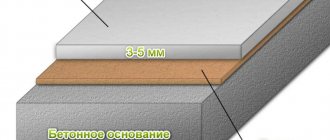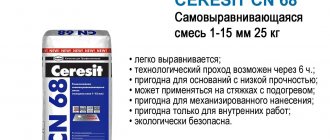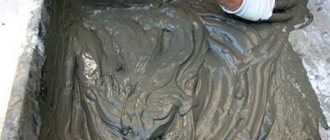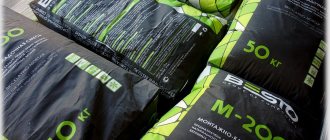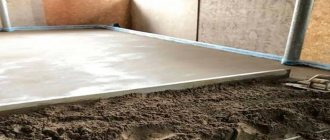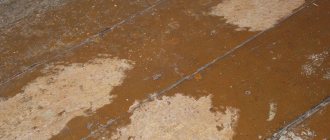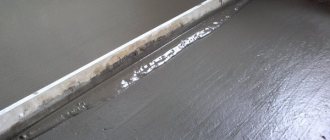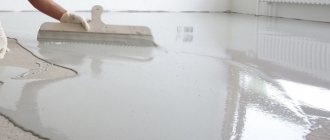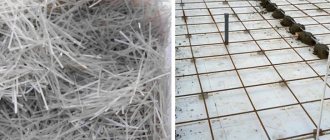Types of self-leveling floors
Depending on the main binder component, self-leveling floors come in five main types:
- cement-acrylic mixtures - moisture-resistant compositions with a rough surface, can be used as a base for flooring;
- methyl methacrylate - chemically resistant mixtures with a short setting time, intended mainly for industrial premises due to the presence of caustic components in the composition;
- polyurethane - durable and elastic compounds that can withstand various aggressive environments;
- epoxy – high-strength self-leveling floors, resistant to various chemicals, but very fragile;
- epoxyurethane - high-strength and elastic mixtures that can withstand heavy loads.
All self-leveling floors can be divided into two large groups according to the method of application.
Some are designed to level out large irregularities and defects on the surface of the base and can be poured in a layer of up to 60-80 mm. Such mixtures (levelers) are intended for rough rough finishing of the floor. They contain a larger fraction of aggregate; the main binder is gypsum or cement. With their help it will not be possible to bring the floor mark to absolute zero; additional finishing will be required.
The second group includes compositions for working with a base that has minor differences. Finishing mixtures are applied in a thin layer - no more than 6-8 mm, and are capable of creating a perfectly smooth surface. To add strength, the composition may include epoxy resins or polymer components.
For the base for laying a sports surface, you should choose the type of mixture that corresponds to the condition of the surface being prepared and the further operating conditions of the room. If it is necessary to eliminate significant differences, then leveling mixtures are needed; finishing mixtures are suitable for correcting minor defects.
In rooms with difficult humidity conditions, you need to choose moisture-resistant compounds. Self-leveling floors not only level the surface and give it horizontality, but also:
- significantly increase its strength, which affects the operation of the floor covering;
- increase the adhesion of the adhesive composition by reducing the porosity of the base (but you should not choose mixtures with a glossy effect);
- significantly reduce the consumption of primers and adhesives when laying linoleum due to a decrease in the absorption of the base.
Types of modern dry floor mixes
Self-leveling floors are all mixtures that have replaced the outdated technology of cement-sand screed. This whole family is divided into two classes:
- Plastic levelers, whose properties are more similar to a screed than to self-leveling mixtures in the traditional sense. All of them are united by the presence of cement or gypsum components mixed with sand. These compounds perform rough leveling of the base; they are applied in a thick layer.
- Finish self-leveling floors, which contain a significant amount of polymer additives. They are designed for final fine leveling of the surface.
Floor leveler
Thick self-leveling floors or levelers differ from traditional cement-sand screeds in the homogeneous fraction, the use of purified components with the addition of plasticizers. These additives reduce porosity and improve the plasticity of the mortar during installation. The compounds are applied according to the same principle as the screed: along the beacons using the rule.
Finishing compounds are capable of spontaneously forming a flat surface under the force of gravity; they are used for fine leveling of the surface.
Finish self-leveling floor
These formulations are recommended to be used in pairs. For the subfloor, use a leveler or a thick self-leveling floor, and for finishing, use a thin-layer leveling mixture.
Preparing the base
When applying a self-leveling floor to a concrete screed, you should know that for its long-term operation, and therefore for the top floor covering, quite stringent requirements are imposed on the base.
First of all, the adhesion of the poured mixture to the surface of the base depends on the quality of preparation. If the technology is violated, during operation the self-leveling floor may peel off and be destroyed.
It is necessary to repair damaged areas, fill large depressions (more than 5 mm) and grind the protrusions. Cracks with a width of 0.4 mm or more should be expanded and filled with epoxy compounds or strengthened with repair solutions using sickle mesh. Smaller cracks, as well as shrinkage joints, must be sealed with sealant. The same applies to junctions near walls.
All grease and oil stains should be removed from the surface of the base; it should be cleared of construction debris and dust-free. To do this, it is recommended to use a construction vacuum cleaner that can remove small particles from deep pores. Special requirements are imposed on the moisture content of the base.
Filling with self-leveling mixtures can only be done on dry surfaces - the moisture content of the screed should not exceed 4%. This is due to the fact that excess moisture can reduce the strength characteristics of the finished surface and also lead to its detachment from the base. Work on the installation of self-leveling floors is allowed to be carried out at an air temperature of 15-25°C and a relative air humidity of no higher than 80%.
Tips and secrets
Small pimples that appear on the subfloor are defects and are removed by sanding. Shallow holes are sealed with a self-leveling floor solution. Before pouring the finishing layer, you need to make sure that the rough surface is absolutely flat.
As for whether a self-leveling floor is needed on a screed, this is not necessary. You can level the surface in other ways - for example, using cement is a widely used option. However, self-leveling floors have a number of advantages.
First of all, they are the best solution for premises that are subject to significant mechanical loads - various industries, car services, etc. In apartments, using self-leveling floors you can create an interesting and original design, and this flooring will last for decades.
It’s not difficult to pour a self-leveling floor onto an old screed, and you can do this job yourself. But during the work and after it, you need to strictly adhere to the technology, since the slightest deviation from it can lead to the coating being hopelessly damaged.
Primer of the base for self-leveling floors
Mostly, cement-sand or concrete screeds serve as the basis for self-leveling floor mixtures. But the former are characterized by high absorbency, which reduces the moisture content in the hardening solution and leads to a loss of strength of the self-leveling coating.
Concrete screeds have a monolithic structure, but a smoother base does not provide the required adhesion. The porosity of the base can be reduced by using special primers that polymerize on the surface and close the pores with a thin latex film, preventing moisture from being absorbed into the subfloor.
On a concrete base, primers containing quartz chips are used to increase the adhesion of the self-leveling floor. After their application, the surface of the screed has a rough texture and looks like fine sandpaper.
The primer should be applied using a roller in two or three steps (according to the manufacturer’s recommendations), and the next layer is applied only after the previous one has completely dried (depending on the composition of the primer, from 4 to 24 hours).
In addition to closing pores and increasing adhesion, penetrating primers can strengthen the top layer of the base by crystallizing in its pores. They also bind tiny particles of dust that cannot be removed mechanically. The choice of primer type is determined by the base
Leveling the floor
When choosing a self-leveling floor for concrete, you should take into account the purpose of the room, the condition and quality of the base, and possible impacts (chemical and mechanical).
Before you start pouring, it is necessary to correct defects on the surface and remove existing grease stains. A poorly prepared surface will lead to imperfections in the finishing coating.
Small cracks are removed using putty; to eliminate large ones, a mixture based on epoxy resin is suitable. Since no special skills are required, you can do all the work yourself.
Preparation
The main component when installing a self-leveling floor on a concrete slab is a high-quality base. If it is not properly prepared and the technology requirements are not met, the coating may become deformed or destroyed.
Existing shrinkage, temperature or other seams are sealed with a special sealant. Cement-sand screed and concrete base are porous, easily absorb moisture, and can be coated with a primer. Cracks are treated with a primer followed by gluing with fiberglass.
The top layer is removed from the old concrete base, the surface is sanded, and potholes and chips are repaired. Remove existing dirt, oil stains and clean the base from dust with an industrial vacuum cleaner.
Pouring concrete screed
The installation of a self-leveling concrete floor begins after the base is completely prepared.
The work is performed in the following sequence:
- Waterproofing is carried out in several ways. Regardless of the method chosen, the film should be laid overlapping, and construction seams should be secured with construction tape.
- Thermal insulation prevents energy loss. The insulation begins to be laid from the far corner, and the joining seams are fixed; The perimeter along the walls is glued.
- When installing beacons, cement mortar is used to fix aluminum guides. The distance between beacons should not be greater than the size of the rule.
- Concrete for pouring is mixed in small portions (to avoid setting while working with the previous batch). They begin to apply the solution from the far corner, using the rule they pull it along the beacons.
- After pouring, you need to go over the screed with a needle roller.
- A polyethylene film is laid on the prepared screed, leaving the concrete floor to gain strength.
Preparation of a self-leveling solution
To final level the screed, a cement-acrylic, polyurethane or epoxy self-leveling floor can be applied to its surface. The technology for laying a self-leveling mixture differs from the installation of an ordinary screed. Since the composition is applied to the surface in a very thin layer, it has a liquid consistency for ease of application.
The solution must be prepared according to the manufacturer's instructions indicated on the packaging. Part of the required water is poured into the container and the dry mixture is poured. The process is carried out in exactly this sequence, otherwise the mixture will not dissolve completely and lumps will form in the solution.
The resulting mass is thoroughly mixed using a mixer attachment on an electric drill, gradually adding the remaining water. After letting the solution settle for 3-5 minutes, stirring is repeated.
Since most self-leveling mixtures are quick-hardening compounds, they have a short “potlife” period during which they must be laid on a prepared base. Typically, the “working time” of self-leveling floors is no more than 30-40 minutes. In this range, the mixtures have sufficient plasticity to ensure uniform spreading over the leveled surface.
If the floor area to be filled is small, then the solution should be prepared for the entire volume at once, otherwise you will have to make several batches, without deviating from the technology and observing the proportions of water and mixture. As a result of preparation, you should get a mixture that resembles the consistency of fatty kefir. But there are times when, due to the hardness of the water, the solution does not have the proper thickness or, on the contrary, is too viscous. In this case, you should change the ratio of water or dry component in the composition, and remembering the quantity, prepare further batches with the same proportion.
The degree of spreadability can be determined in a simple way. It is necessary to pour about 100 ml of solution onto the glass; if within 3-4 minutes it has spread into a spot with a diameter of 18-20 cm, then the composition is suitable for installation.
The mixture consumption depends on the average height of the leveling layer and the volume of defective areas. Typically, the manufacturer indicates the average consumption for a layer of 1 mm. Having determined the maximum and minimum thickness of the self-leveling floor in the room, you can approximately calculate the required amount of dry mixture for installing a self-leveling coating.
Depending on the composition of the components and the brand of the manufacturer, the average consumption of dry mixture per 1 m2 is 1.5-2 kg for each millimeter of layer.
Pouring materials
The possibility of leveling the floor is not limited to concrete mortar. You can purchase dry construction mixtures or mix cement mortar. In addition, there is a wide range of self-leveling mixtures. Therefore, it is important not only to understand the pouring technology, but also to choose the right material.
Let's compare the capabilities of different compositions:
| Type of solution | pros | Minuses |
| Concrete |
|
|
| Cement-sand mixture |
|
|
| Dry construction mixture |
|
|
| Self-leveling floor |
|
|
Packages with ready-made dry mixtures always contain detailed instructions for application. CPS (cement-sand mixture) can be prepared independently by mixing M500 cement and sifted fine river sand in a 1:3 ratio.
The proportions of the concrete solution depend on what kind of screed is poured. The most interesting in this series are self-leveling floors. A little more about them.
Pouring the floor
Laying the self-leveling mixture in the gym starts from the far corner and works towards the door. The solution is poured onto the surface and distributed using a squeegee - a special spatula with a gap height adjuster.
Each subsequent portion should be poured at the junction with the previous one, leveling the border. After the mixture has been distributed over an area of 15-20 m2, it is necessary to roll the entire surface with a needle roller to remove air bubbles from the solution. This is necessary so that after the hydration of the solution is completed, there are no air cavities left in the body of the self-leveling floor, which reduce its strength characteristics.
To move around the freshly poured solution, you can use special shoe pads - paint shoes. The spikes on them, 20-30 mm long, allow you to move on a fresh self-leveling floor without damaging it. All these operations must be carried out during the “survival” period of the mixture.
Depending on the composition of the self-leveling mixture, pre-hardening occurs within 4-24 hours. After this time it is possible to move along it. However, full strength gain and drying occurs after 3-4 weeks, after which it is allowed to lay sports linoleum on a self-leveling floor.
The installation technology must be strictly observed, since in the event of an error, it is impossible to correct the consequences in a local area and the entire coating will have to be dismantled.
Filling methods
Depending on the base, there are several filling methods:
- On a concrete base. The fill acts as a finishing coat. The permissible layer thickness is no more than 15 mm. First, the surface is prepared: it is ground and primed; no additional finishing work is required, but it must be level. After drying, it is painted or varnished.
- Self-leveling concrete floors on cement screed. Using the mixture, you not only level the screed, but also eliminate existing defects. It is important that the screed is dry.
- On a wooden base. The correct choice of brand of mixture is of great importance. The wood should be strong and not creaky. It is necessary to remove the old coating and seal the joints with the walls with styrofoam tapes. The surface is primed, the seams between the boards are puttied.
- On the tile. It is cleaned, the one that holds weakly is removed, and it is degreased. Prime to ensure adhesion.
The chosen method does not affect the filling technology; The following requirements must be met:
- start work from the far corner in the direction of the exit;
- do not rely on beacons;
- drive in a zigzag manner;
- do not leave a lot of unleveled mixture on the floor;
- observe proportions when mixing the solution;
- After pouring is completed, cover the surface with plastic wrap.
Pouring technology
Laying self-leveling floors does not require special knowledge and skills. It's quite simple. Necessary:
- prepare the base well;
- follow instructions;
- Mix correctly and follow the drying schedule.
The cement screed must be undamaged and intact. There are no tubercles allowed on it. All defects must be repaired with mortar and rubbed down. Next, the surface is primed. It will fill the pores and prevent moisture penetration.
When installing, a damper tape is stretched around the perimeter of the room. To form a gap and relieve stress. The room must be maintained at a constant temperature. The most optimal is 15 C. At lower temperatures, the fluidity of the mixture decreases. This makes it difficult to form an even layer. Particularly important for colored formulations. At higher temperatures, you will have to work very quickly to prevent the solution from thickening. The floor should dry in the absence of drafts. It is necessary to monitor the humidity in the room and maintain it at the required level.
Self-leveling floor Weber Vetonit Fast Level
This product from a Russian manufacturer, intended for installing a poured floor, can quickly harden. It goes on sale in three-layer bags of 20 kg.
The composition can be used to level the base from 3 mm to 60 mm. Such coatings are installed in those rooms (wet, dry) where moderate mechanical load is recorded. The flooring can be linoleum, laminate, tile, parquet.
The composition covers the bases:
- gypsum;
- cement-concrete;
- concrete;
- the so-called weak.
It is also suitable for arranging surfaces with a “warm floor” system (electric heating).
To use the solution, the temperature must be between +10 °C and +25 °C.
Main advantages
- It is permissible to lay both a very thin and a fairly thick layer.
- The composition hardens quickly.
- You can walk on such a floor within 3-4 hours after pouring it.
- It is convenient to work with the material.
- The price is set reasonable.
Types of concrete floor screeds
The bases for different types of flooring, which can be used independently, are called concrete screeds. They differ in the technology of filling and, as a consequence, in the conditions of subsequent operation. Concrete floor screed is used to level the base (eliminates cracks, potholes, chips), lay heated floors if necessary, and to prepare the base for the finishing coating. At the same time, the thickness of the concrete layer depends on the need.
To prepare the screed, you can pour concrete over the ground (most often, for the basement of your house or garage), but the most common option is to lay a specially prepared pad or concrete slabs on the area. With its help you can form a surface with a slope. The main advantage of a concrete floor is durability. It is used for the installation of coatings, both in private homes and for industrial premises.
Thus, it is the floor that is most used for various spaces, all buildings have it.
the following criteria for classification:
- degree of adhesion to the base;
- number of layers;
- pouring technology;
- presence of additional ingredients.
The higher the load, the higher the adhesion between layers is required. To obtain the desired result, additional materials (for example, primer) are used.
The number of layers affects the quality of the surface. When forming a screed to the entire required height in one layer, it is difficult to achieve a perfectly flat surface. The multi-layer design allows you to achieve the perfect result.
According to the filling technology, screeds are distinguished:
- wet;
- semi-dry.
The latter option has been used relatively recently, but has already become popular.
In addition, concrete floors are
- laid directly on the base (like a subfloor);
- filled with a separating layer;
- made with waterproofing, insulation, and a sound-absorbing layer.
To solve these problems, additional components are used: expanded clay as insulation, fiber for reinforcement.
Self-leveling floor PLITONIT R Express, quick-hardening
When arranging floors, this product is quite suitable for making interlayers and screeds. The mixture is used during construction or during renovation of buildings for any purpose, including:
- residential;
- public;
- preschool and school;
- sanatorium-resort and medical directions.
The following composition is corrected and leveled using the indicated composition:
- monolithic cement screeds;
- polymer-gypsum screeds;
- concrete floors.
Work is carried out inside office and residential premises that are considered dry or wet. Then you can lay parquet, other flooring or floor tiles. The composition is suitable for installation in a “warm floor” system.
What is the type of binder self-leveling floor?
When purchasing a self-leveling floor, you first need to pay attention to the type of binder. The most popular options used in the production of dry mixes: air
and
hydraulic
.
The first type includes gypsum
and
lime
. Their distinctive feature is that they harden when exposed to air and only under such conditions retain their strength. That is, they cannot be used in rooms with high humidity, and especially on the streets. Despite this significant drawback, they are very easy to use, spread easily, do not crack, and do not shrink.
The most popular representative of hydraulic binders is cement
. On the contrary, such materials feel great in conditions of high humidity and even water. However, such self-leveling floors also have disadvantages. Firstly, cement materials shrink after drying, and secondly, working with such mixtures is much more difficult, since they do not spread as well as gypsum. Accordingly, gypsum self-leveling floors are used only inside dry rooms, while cement floors are universal, they can be used even outside.
However, there is another group that needs to be given special attention, as it is the most popular on the market today. These are self-leveling floors with complex binder
. This is exactly the decision that many manufacturers have come to, combining the advantages of air and hydraulic binders in one material.
It is the type of binder self-leveling floor that you need to pay attention to first of all, because most of the technical characteristics depend on it.
A cement self-leveling floor will be more durable, suitable in most cases, it can even be used outdoors, but such a material is quite difficult to work with, so you should not give it preference when it comes to installing a coating in a domestic room with a normal level of humidity.
Gypsum and complex self-leveling floors usually have a grade strength of 12-15 MPa, maximum 20 MPa. This indicator is sufficient for use in residential premises. It will be convenient to work with such a self-leveling floor, but this option is not suitable for offices, commercial or public premises. Moreover, such materials cannot be used in unheated rooms, since they are demanding in terms of humidity and temperature.
